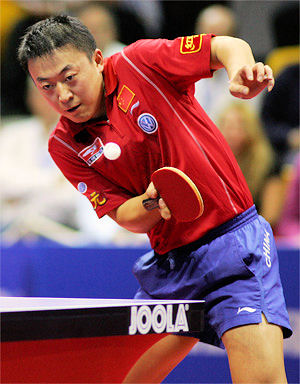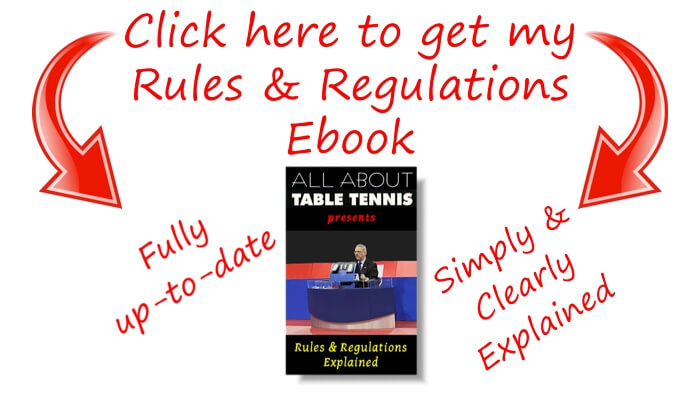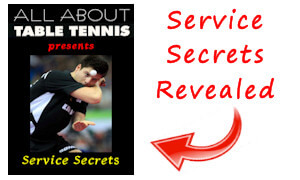You Are Here: Home » Rules of Table Tennis » Can you volley the ball?
A Table Tennis Rule Explained
The Volley
One table tennis rule refers to volleying the ball. So is volleying the ball allowed?
No ... and Yes. Let me explain...
By Martin Hughes
Owner and Editor
 by courtesy of the ITTF
by courtesy of the ITTF
One of the table tennis rules which you'll need to be familiar with is the rule which deals with volleying the ball.
Volleying means intentionally or unintentionally hitting or touching the ball before it bounces on the table or goes out of play.
Previously, if a player volleyed the ball at any time he lost the point, but the rules were subtly changed in the 1990s, so now it depends on the circumstances.
Volleying the ball is covered by the "obstruction" rule, so we'll examine what the rule says and it's purpose.
So let's take a look at this rule and discover what is allowed and what's not allowed.
Need your questions about the Rules and Regulations answered SIMPLY and CLEARLY?
Take a look at this fully up-to-date downloadable book. You'll find everything you need.
Get all the details here...
TABLE TENNIS EXPERT
REVEALS HIS SECRETS
Click Here For Details

Click here for a large selection of
table tennis equipment at Megaspin *

Click here for a large selection of
table tennis equipment at Bribar *
^ Top of page ^
So what does the current rule say?
The obstruction rule
Rule 2.05.08 states...
"A player obstructs the ball if he or she, or anything he or she wears or carries, touches it in play when it is above or travelling towards the playing surface, not having touched his or her court since last being struck by his or her opponent."
^ Top of page ^
So what does that mean?...
The crucial test
The crucial test for whether a player wins a point after his opponent has volleyed the ball is ... was the ball moving towards, or away from, the playing surface when it was volleyed and/or obstructed?
Let me explain with a question and answer...
"If I hit a ball to my opponent, and it doesn't hit their half of the playing surface (table) because it's a bad shot ... but they hit the ball anyway, who gets the point?"
Well, it depends...
If your opponent volleys and/or obstructs the ball whilst it's still travelling over the playing surface, you win the point.
But if the ball has already passed over the playing surface and it's obviously not going to hit the table, your opponent wins the point.
In other words, if there's a chance that the ball might hit the table tennis table because it's still travelling towards it, your opponent would lose the point if he prevented it from doing so by volleying and/or obstructing it.
But...
If the ball has already passed over the table and/or is travelling away from the table, your opponent wins the point whether he volleys and/or obstructs it or not.
Don't forget ... as well as hitting the ball with your racket, if you touch the ball with any part of your body or with anything you carry, the same rule applies.
And this isn't tennis or volleyball!
It's also worth noting that, despite all the subtle changes to this rule, it has never been legal to volley the ball in table tennis like you can when playing tennis.
And it has never been legal to "spike" the ball and then play a shot as you can in volleyball either.
Need your questions about the Rules and Regulations answered SIMPLY and CLEARLY?
Take a look at this fully up-to-date downloadable book. You'll find everything you need.
Get all the details here...
^ Top of page ^
TABLE TENNIS EXPERT
REVEALS HIS SECRETS
Click Here For Details

Click here for a large selection of
table tennis equipment at Megaspin *

Click here for a large selection of
table tennis equipment at Bribar *
So why did this table tennis rule change in the 1990s?
Unfair rule
This rule was changed several times during the 1990s by the International Table Tennis Federation because it was recognised that the original wording of this rule was very unfair.
However, it took several different variations to the wording of this rule before the current version was finally implemented in 2000.
Under the old table tennis rule, a player volleying the ball at any time lost the point - which was particularly unfair in certain situations.
For example, if your opponent played a really bad shot and the ball didn't hit the table but hit you instead (because you were unable to get out of the way in time), you would still lose the point.
^ Top of page ^
So the current table tennis rule is...
A fairer rule
Under the current rule, the intention now is that a player will only be penalised if he intercepts the ball in a way that is likely to prevent an opponent from making a good return.
A player therefore no longer causes an "obstruction" if the interception occurs when the ball has already passed beyond his end line, or has passed outwards over the sideline or is otherwise moving away from the playing surface.
A much more sensible rule!
Need your questions about the Rules and Regulations answered SIMPLY and CLEARLY?
Take a look at this fully up-to-date downloadable book. You'll find everything you need.
Get all the details here...

^ Top of page ^
| MORE PAGES ABOUT THE RULES OF TABLE TENNIS |
|---|
For more information about the rules of table tennis, take a look at my other articles which explain the Official
Laws of Table Tennis and the additional Regulations (for higher level play) in more detail...
The Laws of Table Tennis
Regulations (for higher level play)
General
Frequently Asked Questions
|
Click here for a large selection of
table tennis equipment at Megaspin *

Click here for a large selection of
table tennis equipment at Bribar *
^ Top of page ^
You Are Here: Home » Rules of Table Tennis » Can you volley the ball?
